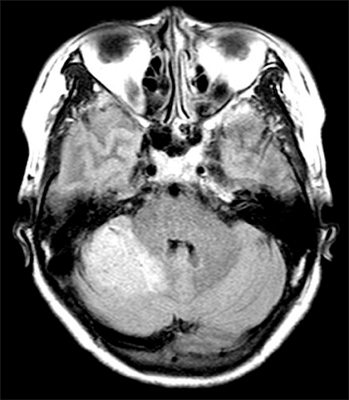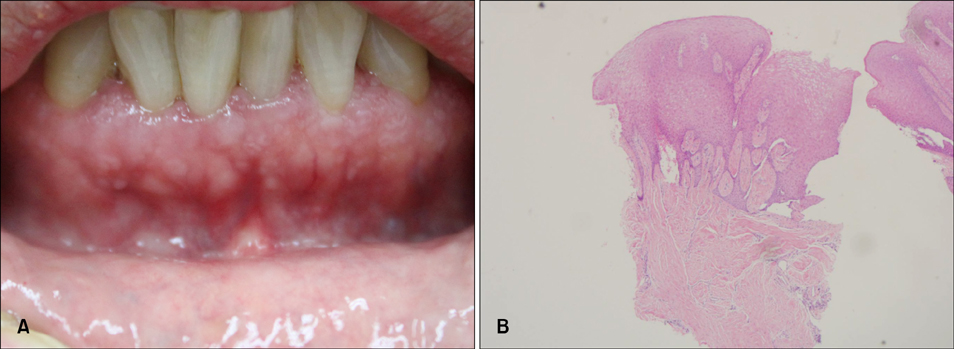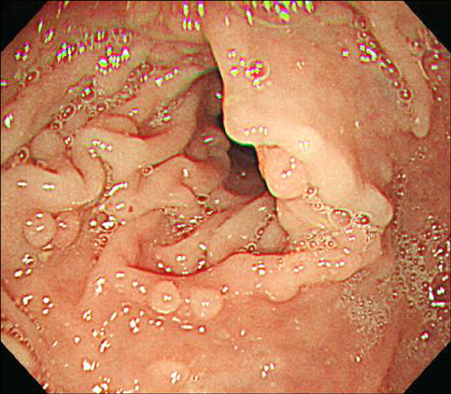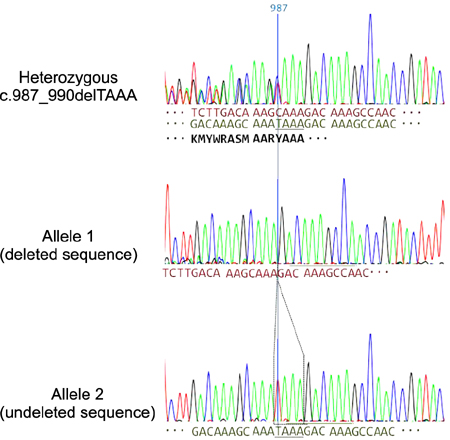Ann Dermatol.
2015 Jun;27(3):306-309. 10.5021/ad.2015.27.3.306.
Cowden Syndrome with a Novel Germline PTEN Mutation and an Unusual Clinical Course
- Affiliations
-
- 1Department of Dermatology, Busan Paik Hospital, Inje University College of Medicine, Busan, Korea. derma09@hanmail.net
- 2Department of Laboratory Medicine, Busan Paik Hospital, Inje University College of Medicine, Busan, Korea.
- KMID: 2352502
- DOI: http://doi.org/10.5021/ad.2015.27.3.306
Abstract
- Here, we report a case of Cowden syndrome with an unusual clinical course of late-onset oral papillomatosis and a novel germline PTEN mutation. Cowden syndrome is the most common phosphatase and tensin homolog hamartomatous tumor syndrome. It is characterized by multiple hamartomas in the gastrointestinal tract and mucocutaneous lesions such as trichilemmomas, oral papillomatosis, facial papules, and acral keratoses. Patients with Cowden syndrome have a higher risk of malignancies, especially breast, colon, and thyroid cancers. A 53-year-old female presented with cobblestone-like papillomatous papules on the lower gums that developed 1 year earlier. She had no other mucocutaneous lesions besides oral papillomatosis. Gastrointestinal endoscopy and colonoscopy revealed multiple hamartomas in the stomach and colon. The patient had a history of breast cancer and multinodular goiter diagnosed 4 and 5 years ago, respectively. She was diagnosed with Cowden syndrome and a novel PTEN mutation was confirmed by direct sequencing.
MeSH Terms
Figure
Reference
-
1. Shah KR, Boland CR, Patel M, Thrash B, Menter A. Cutaneous manifestations of gastrointestinal disease: part I. J Am Acad Dermatol. 2013; 68:189.e1–189.e21.2. Gustafson S, Zbuk KM, Scacheri C, Eng C. Cowden syndrome. Semin Oncol. 2007; 34:428–434.
Article3. Lloyd KM 2nd, Dennis M. Cowden's disease. A possible new symptom complex with multiple system involvement. Ann Intern Med. 1963; 58:136–142.4. McLean DI, Haynes HA. Cutaneous manifestation of intestinal malignant disease. In : Freedberg IM, Eisen AZ, Wolff K, Austen KF, Gold Smith LA, Katz SI, editors. Fitzpatrick's dermatology in general medicine. 6th ed. New York: McGraw-Hill;2003. p. 1789.5. Silva A, Yunes JA, Cardoso BA, Martins LR, Jotta PY, Abecasis M, et al. PTEN posttranslational inactivation and hyperactivation of the PI3K/Akt pathway sustain primary T cell leukemia viability. J Clin Invest. 2008; 118:3762–3774.
Article6. Steck PA, Pershouse MA, Jasser SA, Yung WK, Lin H, Ligon AH, et al. Identification of a candidate tumour suppressor gene, MMAC1, at chromosome 10q23.3 that is mutated in multiple advanced cancers. Nat Genet. 1997; 15:356–362.
Article7. Li DM, Sun H. TEP1, encoded by a candidate tumor suppressor locus, is a novel protein tyrosine phosphatase regulated by transforming growth factor beta. Cancer Res. 1997; 57:2124–2129.8. Tutluer S, Tanriover MD, Guven GS. Cowden syndrome: a major indication for extensive cancer surveillance. Med Oncol. 2012; 29:1365–1368.
Article9. Li J, Yen C, Liaw D, Podsypanina K, Bose S, Wang SI, et al. PTEN, a putative protein tyrosine phosphatase gene mutated in human brain, breast, and prostate cancer. Science. 1997; 275:1943–1947.
Article10. Mukamal LV, Ferreira AF, Jacques Cde M, Amorim CA, Pineiro-Maceira J, Ramos-e-Silva M. Cowden syndrome: review and report of a case of late diagnosis. Int J Dermatol. 2012; 51:1494–1499.
Article11. Eng C. PTEN hamartoma tumor syndrome (PHTS). In : Pagon RA, Adam MP, Ardinger HH, Wallace SE, Amemiya A, Bean LJH, editors. GeneReviews® [Internet]. Seattle (WA): University of Washington, Seattle;2001. 11. 29. updated 2014 Jan 23. cited 2014 May 1. Available from: http://www.ncbi.nlm.nih.gov/books/NBK1488/. .12. Pilarski R. Cowden syndrome: a critical review of the clinical literature. J Genet Couns. 2009; 18:13–27.
Article13. Kanaya T, Kyo S, Sakaguchi J, Maida Y, Nakamura M, Takakura M, et al. Association of mismatch repair deficiency with PTEN frameshift mutations in endometrial cancers and the precursors in a Japanese population. Am J Clin Pathol. 2005; 124:89–96.
Article14. Schmidt EE, Ichimura K, Goike HM, Moshref A, Liu L, Collins VP. Mutational profile of the PTEN gene in primary human astrocytic tumors and cultivated xenografts. J Neuropathol Exp Neurol. 1999; 58:1170–1183.
Article15. Risinger JI, Hayes AK, Berchuck A, Barrett JC. PTEN/MMAC1 mutations in endometrial cancers. Cancer Res. 1997; 57:4736–4738.16. Marsh DJ, Kum JB, Lunetta KL, Bennett MJ, Gorlin RJ, Ahmed SF, et al. PTEN mutation spectrum and genotypephenotype correlations in Bannayan-Riley-Ruvalcaba syndrome suggest a single entity with Cowden syndrome. Hum Mol Genet. 1999; 8:1461–1472.
Article17. Schreibman IR, Baker M, Amos C, McGarrity TJ. The hamartomatous polyposis syndromes: a clinical and molecular review. Am J Gastroenterol. 2005; 100:476–490.
Article18. Hildenbrand C, Burgdorf WH, Lautenschlager S. Cowden syndrome-diagnostic skin signs. Dermatology. 2001; 202:362–366.
- Full Text Links
- Actions
-
Cited
- CITED
-
- Close
- Share
- Similar articles
-
- Identification of a Novel p53 Intronic Mutation in Cowden's Disease
- Cowden Syndrome: A Review
- A Case of Cowden Syndrome with Novel PTEN Gene Mutation
- Cowden's Disease Detected by Gastric Polyposis during Endoscopy in a Routine Check Up: A Case Report
- A Case of Cowden Syndrome Presenting with Diverse Cutaneous Manifestations





